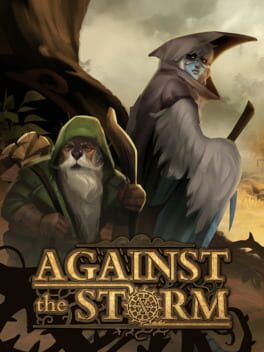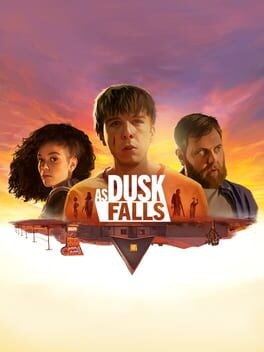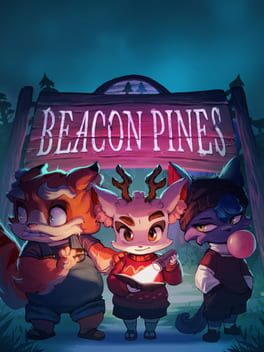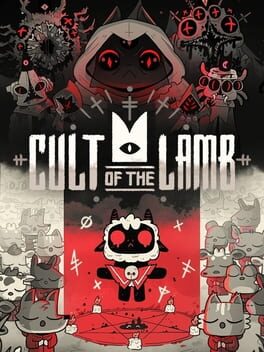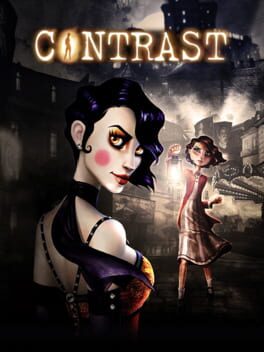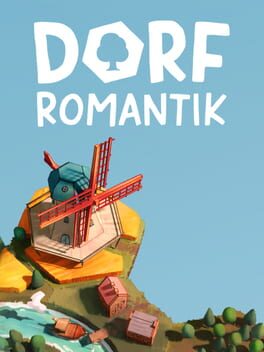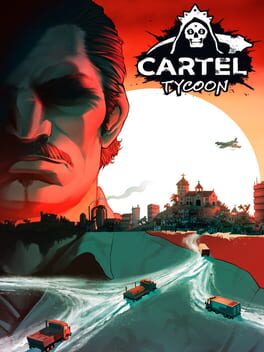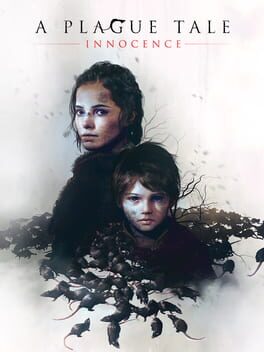Gandheezy22
I reviewed this game with a key provided by the publisher: https://gameluster.com/review-my-big-sister-remastered-narrative-nonsense/
Overall, while the art and world and music are top notch, I can’t really recommend this very narrative heavy game because the story is just a disaster of thematic and tonal clashing at every turn. If this was another kind of game with a heavier combat element or something else to carry the weight, it’d be a different story, but My Big Sister is a narrative. If you are content to just vibe with it for a few hours and let the story be of no consequence, maybe you’ll find a way to enjoy it.
Overall, while the art and world and music are top notch, I can’t really recommend this very narrative heavy game because the story is just a disaster of thematic and tonal clashing at every turn. If this was another kind of game with a heavier combat element or something else to carry the weight, it’d be a different story, but My Big Sister is a narrative. If you are content to just vibe with it for a few hours and let the story be of no consequence, maybe you’ll find a way to enjoy it.
2022
I reviewed this game with a key I was provided by the publisher.
They say not to take your work home with you, but I’ve done a pretty poor job of that. During the day, I work as an urban planner, and at night I come home to play city builder games so I can pretend anything I’m doing has an effect on the well being of citizens. That aside, I’ve always really enjoyed city builders, with Airborne Kingdom being probably my favorite game in the genre. However, each time a new one comes out it feels like there’s some gimmick at the forefront trying to set it apart, which makes sense in the field of such a crowded subgenre. Against the Storm stands out from the crowd because it comes in not with a gimmick, but a new layer - the building of your city is a competition you cannot afford to lose.
Against the Storm takes place in a low-fantasy world that has been destroyed by an apocalyptic storm. The one Sanctuary left is the Citadel, the capitol where the Imperial Queen resides and the remaining civilians in the kingdom have taken refuge. You serve as the Queen’s viceroy and are apparently on thin ice, because the moment you arrive in a new land to start rebuilding civilization the Queen’s impatience begins to rise. The great thing about the impatience meter is that it isn’t just a timer, it’s also related to how happy your citizens are and their work efficiency. On the left hand side is your inspiration meter, built by completing tasks, making citizens happier by clothing and feeding and sheltering them, and expanding the empire. Filling up the inspiration meter first is a victory, and filling up the impatience meter first is a loss. This balancing act is brilliant, because no matter how badly you mess up, or how high your impatience meter is, you can always come back from it with the right strategy.
The art is immediately reminiscent of World of Warcraft, and that’s a huge compliment. One reason that game has survived so long is the timeless fantasy art style that is both pleasing to the eye and harsh with color at once. The musical score in Against the Storm is wonderful, and adds just enough air of ominous mystery without being a distraction. The UI is perfect to navigate, and they allow manual scaling of the elements as well so I can blow them up as large as I like with one click. I must mention this game has an excellently paced tutorial as well, and after 30 minutes you’ll understand every complex feature of this very layered city builder and be ready to roll up your sleeves and get to work.
Against the Storm is also somewhat of a Roguelike - when a city is completed, you’ll return to the citadel and receive praise and money that you can spend on global upgrades for your next town. If your city fails, you return in shame and get nothing but must start a new city elsewhere. Regardless, one of the features that I most dislike in roguelikes is when your deaths just mean restarting. In some games, like Hades, your deaths are canonical, and that’s true of Against the Storm as well. An incoming storm meter ticks forward as you try to build the kingdom out enough across five distinct biomes with enough cities to brace it for the impact of the oncoming apocalyptic storm - do you have what it takes for the kingdom to survive?
A lot of what I’ve described is framing material for the meat of the game, the city building part, but the framing does it a great service. Providing context for the individual actions you take in building out the city is a perfect way to make the player engrossed in what they’re doing because they know there are far reaching consequences that won’t just disappear at the end of the run. And yet, it isn’t too much pressure because, as I said before, you can always make up for your mistakes by simply focusing on quest completion to fill the inspiration meter before the impatience maxes out.
Entering a new settlement area, you’ll begin with a sacred hearth that must be tended to at all times. It needs fuel, such as wood or oil, to continue burning, and probably the only moment of real panic I had in this game was the one time I ran out of fuel. The hearth is very important because all shelters for housing citizens must be within a radius of it, and if it goes out, suddenly you have 40 citizens who are unsheltered and their desperation begins to skyrocket.
Paths are free to build and increase the speed of citizens by 5%, which is fantastic. Besides giving your settlement a sense of direction as it expands, it’s crucial that paths are free to build so you’re encouraged to keep placing key buildings in districts outside the residential ones as you build them out. There are three types of citizens - humans, lizardfolk, and beaverfolk, with a fourth unlockable harpy class later in the game. Each of these classes of citizens have different skill buffs, but importantly none of them are bad at anything - just some are better than others at specific tasks. Humans are better at brewing ale, farming, and gathering; beavers are better at woodcutting and woodwork, and so on. You’ll need to be smart about which citizens you’re sending to do what tasks or run which buildings.
As you gather base resources like food, stone, wood, and minerals, you’ll build the city out by exploring glades. The unexplored parts of the map are covered with a fog of war and separated by wooded areas into open glades. Upon cutting down the necessary trees, you’ll be faced with a glade event which could range from a mysterious cursed idol to a boss battle. How does a boss battle work in a city builder? Surprisingly well, actually. The boss won’t let you build in its glade until defeated, and while fighting it, it will provide a massive debuff to your whole city.
If you want to explore a new building or ruin, or fight a boss, you need a certain amount of a specific supply and 2-3 citizens. For instance, I was nearly defeated by a monster worm that depleted my meat stores every 10 seconds, but required a whopping 40 slabs of meat in order to be satiated and leave. If you ignore a glade even, whether it's an object or a boss, for too long, it’ll cast a massive negative global effect on your city that will very much ruin your day. It’s a perfectly balanced system that at once encourages you to explore, stems the flow of sprawl, and adds a real sense of urgency to tasks now and then. You can also move buildings instantly and for free, which I’ve never seen in a game like this before.
While you’re working, you’ll receive tasks from the queen every few minutes. Each one of these, when completed, earns you a new building type from a small selection and a global buff. Completing all 8 quests is one way to win the run, but they get progressively more difficult and require more complex materials as they go. Alternatively, keeping your citizens happy and active with drinks, entertainment, and nice homes is another way to go. The most effective players will take advantage of both.
Against the Storm is willing to throw out decades long traditions in mechanics of city builders that I didn’t even know I wanted to get rid of until they were gone, and benefits greatly from it. Roads are free to build, buildings are free to move immediately, all citizen classes offer only buffs with no caveats, building construction is instant, every kind of resource can be both mined and crafted from at least 3 kinds of structures, boss fights provide a sense of urgency in building, and every material needed to craft something can be substituted for 5 other materials in a pinch. In tossing out the playbook, developer Eremite Games has created both the most streamlined and exciting city builder I’ve played to date. Perhaps for the same reason Fallout 4 became one of my favorite games of all time, the post-apocalyptic theming of city building adds a gravity to your action that is both heavy and encouraging. I can’t wait to sink several dozen more hours into this game with my lizard friends and show the queen once and for all that i deserve that promotion.
They say not to take your work home with you, but I’ve done a pretty poor job of that. During the day, I work as an urban planner, and at night I come home to play city builder games so I can pretend anything I’m doing has an effect on the well being of citizens. That aside, I’ve always really enjoyed city builders, with Airborne Kingdom being probably my favorite game in the genre. However, each time a new one comes out it feels like there’s some gimmick at the forefront trying to set it apart, which makes sense in the field of such a crowded subgenre. Against the Storm stands out from the crowd because it comes in not with a gimmick, but a new layer - the building of your city is a competition you cannot afford to lose.
Against the Storm takes place in a low-fantasy world that has been destroyed by an apocalyptic storm. The one Sanctuary left is the Citadel, the capitol where the Imperial Queen resides and the remaining civilians in the kingdom have taken refuge. You serve as the Queen’s viceroy and are apparently on thin ice, because the moment you arrive in a new land to start rebuilding civilization the Queen’s impatience begins to rise. The great thing about the impatience meter is that it isn’t just a timer, it’s also related to how happy your citizens are and their work efficiency. On the left hand side is your inspiration meter, built by completing tasks, making citizens happier by clothing and feeding and sheltering them, and expanding the empire. Filling up the inspiration meter first is a victory, and filling up the impatience meter first is a loss. This balancing act is brilliant, because no matter how badly you mess up, or how high your impatience meter is, you can always come back from it with the right strategy.
The art is immediately reminiscent of World of Warcraft, and that’s a huge compliment. One reason that game has survived so long is the timeless fantasy art style that is both pleasing to the eye and harsh with color at once. The musical score in Against the Storm is wonderful, and adds just enough air of ominous mystery without being a distraction. The UI is perfect to navigate, and they allow manual scaling of the elements as well so I can blow them up as large as I like with one click. I must mention this game has an excellently paced tutorial as well, and after 30 minutes you’ll understand every complex feature of this very layered city builder and be ready to roll up your sleeves and get to work.
Against the Storm is also somewhat of a Roguelike - when a city is completed, you’ll return to the citadel and receive praise and money that you can spend on global upgrades for your next town. If your city fails, you return in shame and get nothing but must start a new city elsewhere. Regardless, one of the features that I most dislike in roguelikes is when your deaths just mean restarting. In some games, like Hades, your deaths are canonical, and that’s true of Against the Storm as well. An incoming storm meter ticks forward as you try to build the kingdom out enough across five distinct biomes with enough cities to brace it for the impact of the oncoming apocalyptic storm - do you have what it takes for the kingdom to survive?
A lot of what I’ve described is framing material for the meat of the game, the city building part, but the framing does it a great service. Providing context for the individual actions you take in building out the city is a perfect way to make the player engrossed in what they’re doing because they know there are far reaching consequences that won’t just disappear at the end of the run. And yet, it isn’t too much pressure because, as I said before, you can always make up for your mistakes by simply focusing on quest completion to fill the inspiration meter before the impatience maxes out.
Entering a new settlement area, you’ll begin with a sacred hearth that must be tended to at all times. It needs fuel, such as wood or oil, to continue burning, and probably the only moment of real panic I had in this game was the one time I ran out of fuel. The hearth is very important because all shelters for housing citizens must be within a radius of it, and if it goes out, suddenly you have 40 citizens who are unsheltered and their desperation begins to skyrocket.
Paths are free to build and increase the speed of citizens by 5%, which is fantastic. Besides giving your settlement a sense of direction as it expands, it’s crucial that paths are free to build so you’re encouraged to keep placing key buildings in districts outside the residential ones as you build them out. There are three types of citizens - humans, lizardfolk, and beaverfolk, with a fourth unlockable harpy class later in the game. Each of these classes of citizens have different skill buffs, but importantly none of them are bad at anything - just some are better than others at specific tasks. Humans are better at brewing ale, farming, and gathering; beavers are better at woodcutting and woodwork, and so on. You’ll need to be smart about which citizens you’re sending to do what tasks or run which buildings.
As you gather base resources like food, stone, wood, and minerals, you’ll build the city out by exploring glades. The unexplored parts of the map are covered with a fog of war and separated by wooded areas into open glades. Upon cutting down the necessary trees, you’ll be faced with a glade event which could range from a mysterious cursed idol to a boss battle. How does a boss battle work in a city builder? Surprisingly well, actually. The boss won’t let you build in its glade until defeated, and while fighting it, it will provide a massive debuff to your whole city.
If you want to explore a new building or ruin, or fight a boss, you need a certain amount of a specific supply and 2-3 citizens. For instance, I was nearly defeated by a monster worm that depleted my meat stores every 10 seconds, but required a whopping 40 slabs of meat in order to be satiated and leave. If you ignore a glade even, whether it's an object or a boss, for too long, it’ll cast a massive negative global effect on your city that will very much ruin your day. It’s a perfectly balanced system that at once encourages you to explore, stems the flow of sprawl, and adds a real sense of urgency to tasks now and then. You can also move buildings instantly and for free, which I’ve never seen in a game like this before.
While you’re working, you’ll receive tasks from the queen every few minutes. Each one of these, when completed, earns you a new building type from a small selection and a global buff. Completing all 8 quests is one way to win the run, but they get progressively more difficult and require more complex materials as they go. Alternatively, keeping your citizens happy and active with drinks, entertainment, and nice homes is another way to go. The most effective players will take advantage of both.
Against the Storm is willing to throw out decades long traditions in mechanics of city builders that I didn’t even know I wanted to get rid of until they were gone, and benefits greatly from it. Roads are free to build, buildings are free to move immediately, all citizen classes offer only buffs with no caveats, building construction is instant, every kind of resource can be both mined and crafted from at least 3 kinds of structures, boss fights provide a sense of urgency in building, and every material needed to craft something can be substituted for 5 other materials in a pinch. In tossing out the playbook, developer Eremite Games has created both the most streamlined and exciting city builder I’ve played to date. Perhaps for the same reason Fallout 4 became one of my favorite games of all time, the post-apocalyptic theming of city building adds a gravity to your action that is both heavy and encouraging. I can’t wait to sink several dozen more hours into this game with my lizard friends and show the queen once and for all that i deserve that promotion.
2022
While I enjoyed the first half of this game all right, the second half is a compilation of some of the worst writing and dumbest character moments I have ever seen in a game. Some of the positives here are that I really like the art, the English voice acting is actually pretty good, and it had some interesting characters presented at the beginning. It's just one of those stories where the entire truth of what's happening hinges on the game just not telling you things. There's nothing to solve or investigate or figure out, so there's no way you'll know what's happening until it's already happening and at that point it will seem extremely stupid and out of character. Most of these characters almost seemed like different people in the second half of the game and none of them got an appropriate ending. I do not recommend wasting your time on this.
2022
2022
2022
There is something magical about getting to tell a story and working for the ending it deserves. It's one of the things that made me love the Nier games, Life is Strange, Zero Escape, and Telltale, but even if there's not much resistance, earning an end is something that hits hard for me. Beacon Pines not only feels like you are working to earn the ending the story deserves, but that the story is desperately trying to get you there. In a strange way, it's a co-op experience between the player and the game.
This gorgeous game is a children's storybook come to life, and has some of the most heartfelt and real characters I've seen in a game, especially children. Child characters are notoriously hard to write, but Beacon Pines nails it and delivers a vibe akin to Stand By Me or IT as a group of kids in search of adventure get tangled up in something much more dire than they could realize. By advancing the story you collect words, and these words can be applied in other parts of the story to fill in the blanks and branch the story into several paths.
The narrator, Kirsten Mize, delivers probably one of my favorite voice performances in a video game ever. She is passionate, hopeful, scared, and brave all at once, and brings real weight to even the most trivial of events. I played this game with a friend and recorded that Let's Play for Youtube, which you can check out at https://youtube.com/gameluster ! We had an amazing time doing the voices for the characters and feeling real emotion through the screen.
The narrator needs your help, trapped in a spiral of bad endings that she simply CANNOT allow to be the end. Take the time to help her find the ending we all deserve. It's well worth the time.
This gorgeous game is a children's storybook come to life, and has some of the most heartfelt and real characters I've seen in a game, especially children. Child characters are notoriously hard to write, but Beacon Pines nails it and delivers a vibe akin to Stand By Me or IT as a group of kids in search of adventure get tangled up in something much more dire than they could realize. By advancing the story you collect words, and these words can be applied in other parts of the story to fill in the blanks and branch the story into several paths.
The narrator, Kirsten Mize, delivers probably one of my favorite voice performances in a video game ever. She is passionate, hopeful, scared, and brave all at once, and brings real weight to even the most trivial of events. I played this game with a friend and recorded that Let's Play for Youtube, which you can check out at https://youtube.com/gameluster ! We had an amazing time doing the voices for the characters and feeling real emotion through the screen.
The narrator needs your help, trapped in a spiral of bad endings that she simply CANNOT allow to be the end. Take the time to help her find the ending we all deserve. It's well worth the time.
2022
I'm dancing between a 7 and 8 for this game, but what the hell, giving it an 8 for the ambition on clear display here. Firstly I recommend playing this game with a friend, as the fun of it for me was theorizing, speculating, and discussing constantly what was going on and what was happening, going back and forth with "play that again!" or "wait I have an idea". I do not believe I personally would have enjoyed or even finished this game solo.
I cannot talk too much about what the game's about based on the inherent nature of what it is, but my main issue lies in the total RNG nature of the progression. It could take you anywhere from 3 to 18 hours to find all the critical clips (as I've seen from dozens of forums and steam reviews) and while it took us precisely 10 hours to hit credits, the credits weren't really all of it.
In fact, we were still missing 3 critical scenes to piece the story together, which we'd been trying to do for hours up to then. The credits should have probably indicated the end of the game, but a major chunk of the story was still missing. In the end, we had to look up what happened, read about the critical clips we missed, and then spend an additional 45 minutes brute-forcing this match cuts by clicking on Marissa's face over and over and over to get those scenes.
I have seen dozens of posts of people who gave up on this because they kept looping into the same scenes over and over. I don't blame them. There was a good hour where we kept match cutting and got literally nothing new, and I was ready to give up. Immortality is one of the most experimental games ever, and while the concept is brilliant and the actors, especially Manon Gage, give award worthy performances, it just feels like it doesn't respect the players' time at all. It might just be too experimental, if that makes sense. I think this game is far, far better than Her Story but I also think Sam Barlow needs some editors to remind him about the practicality of a person spending their time to play a game. You have to trade players some indication of progress every so often or you're consuming their time for nothing.
I never had an "aha" moment, we figured it out very slowly but I had such a great time with my friend over these 10 hours that I'd be remiss for not complimenting Barlow and Half Mermaid studios on their ability to create one of the first, genuine mysteries I've seen in a video game. If this game was intended to convince me I'd be a terrible detective in real life, then it has succeeded mightily. But hey, filming three full movies to make a game? That takes guts.
I cannot talk too much about what the game's about based on the inherent nature of what it is, but my main issue lies in the total RNG nature of the progression. It could take you anywhere from 3 to 18 hours to find all the critical clips (as I've seen from dozens of forums and steam reviews) and while it took us precisely 10 hours to hit credits, the credits weren't really all of it.
In fact, we were still missing 3 critical scenes to piece the story together, which we'd been trying to do for hours up to then. The credits should have probably indicated the end of the game, but a major chunk of the story was still missing. In the end, we had to look up what happened, read about the critical clips we missed, and then spend an additional 45 minutes brute-forcing this match cuts by clicking on Marissa's face over and over and over to get those scenes.
I have seen dozens of posts of people who gave up on this because they kept looping into the same scenes over and over. I don't blame them. There was a good hour where we kept match cutting and got literally nothing new, and I was ready to give up. Immortality is one of the most experimental games ever, and while the concept is brilliant and the actors, especially Manon Gage, give award worthy performances, it just feels like it doesn't respect the players' time at all. It might just be too experimental, if that makes sense. I think this game is far, far better than Her Story but I also think Sam Barlow needs some editors to remind him about the practicality of a person spending their time to play a game. You have to trade players some indication of progress every so often or you're consuming their time for nothing.
I never had an "aha" moment, we figured it out very slowly but I had such a great time with my friend over these 10 hours that I'd be remiss for not complimenting Barlow and Half Mermaid studios on their ability to create one of the first, genuine mysteries I've seen in a video game. If this game was intended to convince me I'd be a terrible detective in real life, then it has succeeded mightily. But hey, filming three full movies to make a game? That takes guts.
2022
Cult of the Lamb is likely not exactly what you think it is. While the flashy roguelike action has drawn a lot of comparisons to Hades, it’s not really the crux of the game. At its core, developer Massive Monster’s new ultra-cute cult simulator is just that - a simulation. Players will spend around 75% of its 14 hour runtime playing a masterfully designed city-builder/management sim, with bursts in between of mediocre roguelike action that far out stays its welcome weighed down in poorly paced progression systems.
In Cult of the Lamb, you’ll become a lamb sent to slaughter in the name of a false god. On your way to hell, you’re rescued by a demon called The One Who Waits, who has been shackled between the surface world and inferno. In exchange for sending you back to the world above with its remaining power, it tasks the Lamb with creating a cult in its name, in the name of the Red Crown. There are four bishops, who serve as the bosses, that the Lamb must defeat while managing their cult compound to free The One Who Waits from its demonic chains.
I first want to speak about the thing that draws the most attention in Cult of the Lamb - the art style. It’s beautiful, it’s colorful, it’s easy to distinguish in the heat of combat, and most importantly it’s consistent. Even during the garish occult rituals and demonic summonings, the presentation of Cult of the Lamb never, ever wavers. The artists and animators are 110% dedicated to making this the most adorable Satanic ritual you’ve ever experienced, and do not back down. The contrast of the subject matter and art style is not just something to catch players eyes - it’s an aesthetic decision that was made with purpose.
As I mentioned previously, Cult of the Lamb is a management sim supported by small chunks of roguelike action. You’d be forgiven for thinking the management part is secondary based on the trailers, but really the game is about growing your cult and making them more powerful while the runs through the four procedurally generated biomes serve to help you gather followers and materials for building. Each run is actually quite short, depending on what you run into; I had some that were as quick as 3 minutes, with the longest being about 10.
Cult of the Lamb, like any good management sim, is made up of a dozen interlocking systems, each one both feeding and being dependent on several others. As the game progresses and your cult expands, you’ll be able to automate these processes so you can focus on more high level planning. It very much has the cadence of a city-builder RTS like the Tycoon games, but on a much smaller and more palpable scale for newcomers to the genre.
After inducting your first few cultists (those are freebies), you’ll need to construct your most important structures - a shrine and a temple. The shrine is the beating heart of your cult, and is where your followers will worship you so you can gain power over the course of your journey. The temple is the brain, where you will make the decisions that affect your followers, tell them how to live their lives, dictate their eating, sleeping and working schedules, and more.
From there, you’ll branch out and need to collect rocks, wood, grass, flowers, seeds, food and a variety of other materials so your cult can thrive. There’s three meters you’re trying to maintain - loyalty, hunger, and sickness. If your loyalty depletes, your followers will revolt and declare you a false prophet, leaving the camp. If your hunger depletes, your followers will begin to starve and die. Likewise, if the sickness meter hits 0 disease will begin to spread and followers will be similarly snuffed out.
There are nearly two dozen systems running in the camp by the time it's operational, and it is frankly mind blowing that they all work together so well and never become overwhelming. Like any good management game, it’s all about getting better stuff so you can automate your basic systems, then automate those systems, and so on and so forth. At first you’re scrounging for berry seeds to put together meager meals for your cult, but 6 hours later you’ve got an industrial farm complete with fertilizer and irrigation automation.
You’ll construct housing for your followers, decorations to brighten the place up, and lots of idols to increase the amount of faith you’re collecting each day. All of these systems lead directly into leveling up your Lamb. Each day, you can host one sermon, which feeds skill points into a tree that increases your attack power while increasing loyalty. You can also declare a new doctrine if you have enough tablets, which are gained by doing nice things for your followers. They’ll age and die and you’ll find new ones over time, and restart the cycle.
New doctrines can either be passive buffs for your camp or active rituals that can be cast with a 2 day cooldown. Roughly half these doctrines aid you in leading by way of love, and the other half by way of fear, so you can definitely choose what kind of cult you would like to run. I only picked the love-based doctrines because I am a merciful god Lamb and would bestow my grace upon this flock. But you can go full dictator on it if you wish.
One of the best parts of Cult of the Lamb is that you can name and customize your followers, so, like most everyone, I named them after my real life friends and asked everyone which animal and what color they’d like to be. Everyone had a good time watching their antics as one friend would report another as a traitor, or when two of my friends who barely know each other fell in love, or when one of them showed up at camp covered in blood and just died without explanation. There are certainly other games where you can name characters, but the concept of the social interactions takes the interesting part of Miitopia and Tomodachi Life and puts it into a good game instead.
Now it’s time to talk about the mediocre part of it - the roguelike action stuff. At the beginning of each run, you’re given a weapon and a curse, which is a magic spell. Defeating enemies gains fervor, which is in turn used to cast spells. Simple enough. You’ll unlock tarot cards that give small buffs, like turning your weapons to poison or raising your crit chance, and collect a different assortment on each run. And that’s it. The color palette changes between the four biomes, and there’s a few monsters that are unique to each, but they all effectively do the same thing. As I was spending just a few minutes at a time in combat before heading back to the farm, it didn’t hit me until about 7 or 8 hours in that the combat had not changed. The way that it feels at the beginning is the way it will feel in hour 14, just with new (mostly worse) weapons and upgraded versions of the same spells. The combat is smooth, quick, and certainly eye-catching, but without any additional layers it grows boring after a time.
This leads to my next, much bigger issue: progression. The management sim in this game was not designed with me in mind, who put 20 hours into Factorio over just two days and who builds large scale automated mining operations in Minecraft for fun. As i normally would with a game in this genre, I optimized my followers and automated them, then automated the automations, and so on. I ran a sermon every day, ran as many rituals as possible, upgraded my worship speeds right at the beginning to accrue faster over the life of the game, and talked to every follower to inspire them every single day and extort resources from them. I also mostly ignored the side quests, because mathematically the amount of loyalty you lose for accepting and then not doing them can easily be made up with a single ritual the next day.
There’s a saying that if given a chance, players will optimize the fun out of a game. Well, I did it, and I did it barely halfway through. As I was early on in the third biome, I completed the doctrine tree, the sermon tree, the fishing quests, the mushroom quests, and everything useful in the camp tree. What this resulted in was no progress for the last 5 hours of the game. I had already finished everything the game had to offer, so the next few hours were just maintaining my camp for no reward and outputting resources that would never be used. It slammed to a crashing halt. There is a difficulty modifier for combat, but god I wish there had been a hard mode for the management part of it. I never struggled with collecting enough of anything, and if I didn't have enough resources my automated systems would have it ready for me in just minutes regardless. Perhaps I got too eager, but as a fanatic lover of management games and city builders this was hugely disappointing. Imagine playing Fallout and hitting a level cap halfway through the main story and having to continue without the small reward of simply leveling up.
Another issue that really put a damper on my experience was the requirement to have 20 living followers to fight the final boss. The second biome required me to have 9 to enter, the third required me to have 10, and the fourth required me to have 12. However, to face the final boss I needed to find 8 more. This was such a strange ramp up in requirements I did not expect. In addition, one of the features of the fourth biome is that your followers are summoned and possessed and you must kill them to progress, so right after losing 4 followers in this way I was presented with a gate telling me to find 8 more to proceed.
It’s not actually all that simple - you can buy one follower a day from a spider nearby, but you cannot just fast forward through the days and buy them because your followers will continue to age and die. Rather, I had to basically speedrun 4 more runs hoping that my current elderly followers wouldn’t drop dead any second so i could grind out more cultists. It was not fun in the least. While narratively satisfying, the final boss was also a disappointing fight that lacked a single new combat element.
The first 8 hours of Cult of the Lamb were magical, and if the game had ended somewhere there this review score would be a 10. But it doesn’t, and it goes on and on and gets less and less interesting as it reaches the conclusion. With progression systems that are way too easy to bust and combat that goes stale halfway through, my time with this game did not sustain the high I felt at the beginning. But there are strokes of a masterpiece in here, with excellent music, whimsical characters, starkly themed visuals, just enough narrative push, and management tools that allow for the player to really experience their own story. If you don’t optimize the fun out of Cult of the Lamb, there’s an incredible amount of it to be had.
In Cult of the Lamb, you’ll become a lamb sent to slaughter in the name of a false god. On your way to hell, you’re rescued by a demon called The One Who Waits, who has been shackled between the surface world and inferno. In exchange for sending you back to the world above with its remaining power, it tasks the Lamb with creating a cult in its name, in the name of the Red Crown. There are four bishops, who serve as the bosses, that the Lamb must defeat while managing their cult compound to free The One Who Waits from its demonic chains.
I first want to speak about the thing that draws the most attention in Cult of the Lamb - the art style. It’s beautiful, it’s colorful, it’s easy to distinguish in the heat of combat, and most importantly it’s consistent. Even during the garish occult rituals and demonic summonings, the presentation of Cult of the Lamb never, ever wavers. The artists and animators are 110% dedicated to making this the most adorable Satanic ritual you’ve ever experienced, and do not back down. The contrast of the subject matter and art style is not just something to catch players eyes - it’s an aesthetic decision that was made with purpose.
As I mentioned previously, Cult of the Lamb is a management sim supported by small chunks of roguelike action. You’d be forgiven for thinking the management part is secondary based on the trailers, but really the game is about growing your cult and making them more powerful while the runs through the four procedurally generated biomes serve to help you gather followers and materials for building. Each run is actually quite short, depending on what you run into; I had some that were as quick as 3 minutes, with the longest being about 10.
Cult of the Lamb, like any good management sim, is made up of a dozen interlocking systems, each one both feeding and being dependent on several others. As the game progresses and your cult expands, you’ll be able to automate these processes so you can focus on more high level planning. It very much has the cadence of a city-builder RTS like the Tycoon games, but on a much smaller and more palpable scale for newcomers to the genre.
After inducting your first few cultists (those are freebies), you’ll need to construct your most important structures - a shrine and a temple. The shrine is the beating heart of your cult, and is where your followers will worship you so you can gain power over the course of your journey. The temple is the brain, where you will make the decisions that affect your followers, tell them how to live their lives, dictate their eating, sleeping and working schedules, and more.
From there, you’ll branch out and need to collect rocks, wood, grass, flowers, seeds, food and a variety of other materials so your cult can thrive. There’s three meters you’re trying to maintain - loyalty, hunger, and sickness. If your loyalty depletes, your followers will revolt and declare you a false prophet, leaving the camp. If your hunger depletes, your followers will begin to starve and die. Likewise, if the sickness meter hits 0 disease will begin to spread and followers will be similarly snuffed out.
There are nearly two dozen systems running in the camp by the time it's operational, and it is frankly mind blowing that they all work together so well and never become overwhelming. Like any good management game, it’s all about getting better stuff so you can automate your basic systems, then automate those systems, and so on and so forth. At first you’re scrounging for berry seeds to put together meager meals for your cult, but 6 hours later you’ve got an industrial farm complete with fertilizer and irrigation automation.
You’ll construct housing for your followers, decorations to brighten the place up, and lots of idols to increase the amount of faith you’re collecting each day. All of these systems lead directly into leveling up your Lamb. Each day, you can host one sermon, which feeds skill points into a tree that increases your attack power while increasing loyalty. You can also declare a new doctrine if you have enough tablets, which are gained by doing nice things for your followers. They’ll age and die and you’ll find new ones over time, and restart the cycle.
New doctrines can either be passive buffs for your camp or active rituals that can be cast with a 2 day cooldown. Roughly half these doctrines aid you in leading by way of love, and the other half by way of fear, so you can definitely choose what kind of cult you would like to run. I only picked the love-based doctrines because I am a merciful god Lamb and would bestow my grace upon this flock. But you can go full dictator on it if you wish.
One of the best parts of Cult of the Lamb is that you can name and customize your followers, so, like most everyone, I named them after my real life friends and asked everyone which animal and what color they’d like to be. Everyone had a good time watching their antics as one friend would report another as a traitor, or when two of my friends who barely know each other fell in love, or when one of them showed up at camp covered in blood and just died without explanation. There are certainly other games where you can name characters, but the concept of the social interactions takes the interesting part of Miitopia and Tomodachi Life and puts it into a good game instead.
Now it’s time to talk about the mediocre part of it - the roguelike action stuff. At the beginning of each run, you’re given a weapon and a curse, which is a magic spell. Defeating enemies gains fervor, which is in turn used to cast spells. Simple enough. You’ll unlock tarot cards that give small buffs, like turning your weapons to poison or raising your crit chance, and collect a different assortment on each run. And that’s it. The color palette changes between the four biomes, and there’s a few monsters that are unique to each, but they all effectively do the same thing. As I was spending just a few minutes at a time in combat before heading back to the farm, it didn’t hit me until about 7 or 8 hours in that the combat had not changed. The way that it feels at the beginning is the way it will feel in hour 14, just with new (mostly worse) weapons and upgraded versions of the same spells. The combat is smooth, quick, and certainly eye-catching, but without any additional layers it grows boring after a time.
This leads to my next, much bigger issue: progression. The management sim in this game was not designed with me in mind, who put 20 hours into Factorio over just two days and who builds large scale automated mining operations in Minecraft for fun. As i normally would with a game in this genre, I optimized my followers and automated them, then automated the automations, and so on. I ran a sermon every day, ran as many rituals as possible, upgraded my worship speeds right at the beginning to accrue faster over the life of the game, and talked to every follower to inspire them every single day and extort resources from them. I also mostly ignored the side quests, because mathematically the amount of loyalty you lose for accepting and then not doing them can easily be made up with a single ritual the next day.
There’s a saying that if given a chance, players will optimize the fun out of a game. Well, I did it, and I did it barely halfway through. As I was early on in the third biome, I completed the doctrine tree, the sermon tree, the fishing quests, the mushroom quests, and everything useful in the camp tree. What this resulted in was no progress for the last 5 hours of the game. I had already finished everything the game had to offer, so the next few hours were just maintaining my camp for no reward and outputting resources that would never be used. It slammed to a crashing halt. There is a difficulty modifier for combat, but god I wish there had been a hard mode for the management part of it. I never struggled with collecting enough of anything, and if I didn't have enough resources my automated systems would have it ready for me in just minutes regardless. Perhaps I got too eager, but as a fanatic lover of management games and city builders this was hugely disappointing. Imagine playing Fallout and hitting a level cap halfway through the main story and having to continue without the small reward of simply leveling up.
Another issue that really put a damper on my experience was the requirement to have 20 living followers to fight the final boss. The second biome required me to have 9 to enter, the third required me to have 10, and the fourth required me to have 12. However, to face the final boss I needed to find 8 more. This was such a strange ramp up in requirements I did not expect. In addition, one of the features of the fourth biome is that your followers are summoned and possessed and you must kill them to progress, so right after losing 4 followers in this way I was presented with a gate telling me to find 8 more to proceed.
It’s not actually all that simple - you can buy one follower a day from a spider nearby, but you cannot just fast forward through the days and buy them because your followers will continue to age and die. Rather, I had to basically speedrun 4 more runs hoping that my current elderly followers wouldn’t drop dead any second so i could grind out more cultists. It was not fun in the least. While narratively satisfying, the final boss was also a disappointing fight that lacked a single new combat element.
The first 8 hours of Cult of the Lamb were magical, and if the game had ended somewhere there this review score would be a 10. But it doesn’t, and it goes on and on and gets less and less interesting as it reaches the conclusion. With progression systems that are way too easy to bust and combat that goes stale halfway through, my time with this game did not sustain the high I felt at the beginning. But there are strokes of a masterpiece in here, with excellent music, whimsical characters, starkly themed visuals, just enough narrative push, and management tools that allow for the player to really experience their own story. If you don’t optimize the fun out of Cult of the Lamb, there’s an incredible amount of it to be had.
2016
2013
An absolutely gorgeous game that makes full use of my favorite aesthetic (is there a name for Tim Burton Noire?) with a very interesting premise. Some of the puzzles were excellent, but frankly a lot of them were less than stellar because the physics of light shifting simply didn't work right sometimes. I think if the game mechanics worked as intended I'd easily bump this up a point, but the bugginess definitely had me rolling my eyes a few times.
I LOVED this story. It was incredibly engaging and kept me very intensely wanting to finish the game in one sitting, which I did. It's only about 3 hours long, but it's full of great performances as well. Contrast requires precise platforming and physics manipulation of you and just doesn't have the game engine to match it, which is a shame. A little ambitious beyond its technical abilities, but whatever Compulsion Games is working on now with a Microsoft budget has me excited.
I LOVED this story. It was incredibly engaging and kept me very intensely wanting to finish the game in one sitting, which I did. It's only about 3 hours long, but it's full of great performances as well. Contrast requires precise platforming and physics manipulation of you and just doesn't have the game engine to match it, which is a shame. A little ambitious beyond its technical abilities, but whatever Compulsion Games is working on now with a Microsoft budget has me excited.
2021
2021
Overall, I enjoyed my time with Cartel Tycoon, and I may pop back in when I get a hankering for a management game. There are a lot of systems, perhaps a bit too many, but automation is easy enough and the speed at which they’re introduced to you is manageable. I’d like to see some better written characters in the future as well as Spanish VO, and maybe at some point the darker parts of the real cartel life need to be touched on and addressed. It’s a good time, although certainly not relaxing, but if you feel like you’ll enjoy this management sim you probably will. And hey, if there’s a way to explore your city once you build it up, I will most certainly be back.
Full review at https://gameluster.com/review-cartel-tycoon-somehow-i-manage/
Full review at https://gameluster.com/review-cartel-tycoon-somehow-i-manage/
2021
This game blew me away. What an incredible step up from its predecessor. Almost every level in this game was a masterpiece, and although the ending and last level felt a little shaky, it didn't take away too much from the absolute high I was riding.
Story was fine, but with some great voice acting and gorgeous visuals to back it up. Music wasn't too shabby either. I have very, very few comments for IOI on this. You did it, you sons a bitches.
Finally a game has made me feel that exact sensation that Dishonored does - there are, dare I say, some levels in Hitman 3 that rival or even outdo some of the ones in the Dishonored series. And from me, that is the highest praise I could give an immersive sim. Off to Deus Ex!
Story was fine, but with some great voice acting and gorgeous visuals to back it up. Music wasn't too shabby either. I have very, very few comments for IOI on this. You did it, you sons a bitches.
Finally a game has made me feel that exact sensation that Dishonored does - there are, dare I say, some levels in Hitman 3 that rival or even outdo some of the ones in the Dishonored series. And from me, that is the highest praise I could give an immersive sim. Off to Deus Ex!
2018
A Plague Tale is just one of those games that is so unique that all you're left wanting at the end is more. No one else is making games like this right now. Stealth games with real stealth-based combat and puzzle solving - the stealth IS the puzzle, that's the key. Metal Gear Solid is close, but this grand adventure thing with a powerful linear narrative helps guide it so well.
Plague Tale also has some absolutely incredible music, and the first 2 acts of the narrative are heart-rending. I played this game with French voice acting not for the sake of immersion but because I really found Amicia's English voice off-putting. I also speak French fairly well so I could follow along without watching the subtitles too closely. The VA was stellar, some of the best I've heard this year.
The last act feels artificially elongated with characters acting illogically to basically lengthen the game time, but Chapter XIV sneaking into the castle is one of my favorite segments of any game ever. A Plauge Tale definitely hits some of the same pleasure centers for me as Dishonored, being equipped with a wide set of tools and being asked to use them to solve puzzles. The guards are, to be honest, not that intelligent, but it's a fantastic time nonetheless working around the rats and with the light puzzles.
The last boss was, to put it bluntly, kind of bull shit. The game has been a stealth game up till now and suddenly the final act is Dark Souls? I'm dodge rolling away from a man made of rats doing giant slams. Meanwhile, the previous bossfight, against Nicolas the executioner, was excellent. It used stealth in an intelligent way as a form of combat, and it makes me even more upset that he wasn't the final boss. Why the Inquisitor? Sure, he's more powerful, but the inquisitor has no emotional connection to Amicia. Nicolas killed her father, tortured her mother and brother, killed her friend Arthur. He should have been the final boss and it was a grave misstep lunking that honor off to a Emperor Palpatine rip-off with even less character we met 2 hours before.
Despite this qualms I had SO much fun with this game. I loved these characters, especially Amicia, who is a greatly compelling protagonist, and all the supporting cast, especially Lucas and Mellie. While the narrative gets messy at the end, it still doesn't lose sight of the themes of forgiving your loved ones. Great work, and I am absolutely psyched for Requiem. If they can fix a few things we'll definitely be in 9 territory!
Plague Tale also has some absolutely incredible music, and the first 2 acts of the narrative are heart-rending. I played this game with French voice acting not for the sake of immersion but because I really found Amicia's English voice off-putting. I also speak French fairly well so I could follow along without watching the subtitles too closely. The VA was stellar, some of the best I've heard this year.
The last act feels artificially elongated with characters acting illogically to basically lengthen the game time, but Chapter XIV sneaking into the castle is one of my favorite segments of any game ever. A Plauge Tale definitely hits some of the same pleasure centers for me as Dishonored, being equipped with a wide set of tools and being asked to use them to solve puzzles. The guards are, to be honest, not that intelligent, but it's a fantastic time nonetheless working around the rats and with the light puzzles.
The last boss was, to put it bluntly, kind of bull shit. The game has been a stealth game up till now and suddenly the final act is Dark Souls? I'm dodge rolling away from a man made of rats doing giant slams. Meanwhile, the previous bossfight, against Nicolas the executioner, was excellent. It used stealth in an intelligent way as a form of combat, and it makes me even more upset that he wasn't the final boss. Why the Inquisitor? Sure, he's more powerful, but the inquisitor has no emotional connection to Amicia. Nicolas killed her father, tortured her mother and brother, killed her friend Arthur. He should have been the final boss and it was a grave misstep lunking that honor off to a Emperor Palpatine rip-off with even less character we met 2 hours before.
Despite this qualms I had SO much fun with this game. I loved these characters, especially Amicia, who is a greatly compelling protagonist, and all the supporting cast, especially Lucas and Mellie. While the narrative gets messy at the end, it still doesn't lose sight of the themes of forgiving your loved ones. Great work, and I am absolutely psyched for Requiem. If they can fix a few things we'll definitely be in 9 territory!

